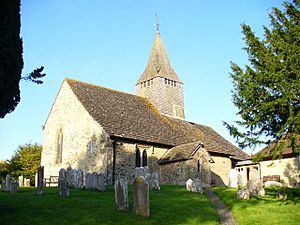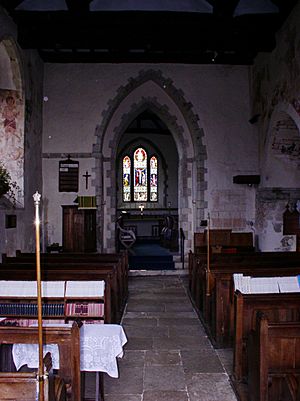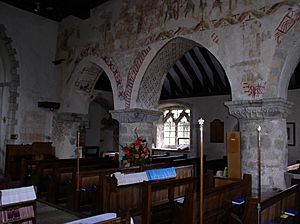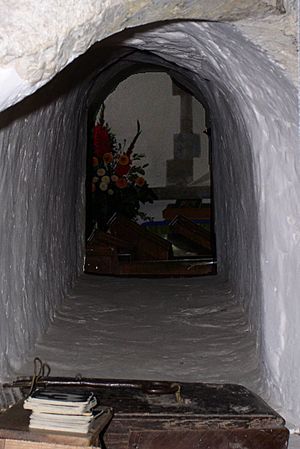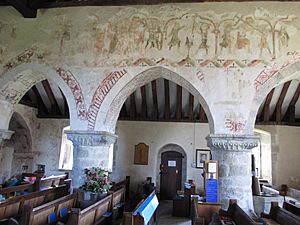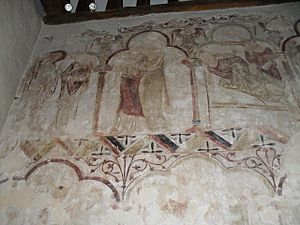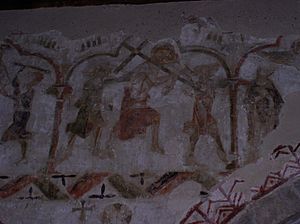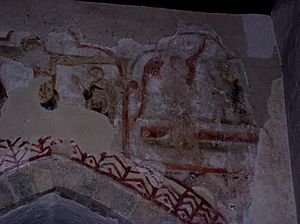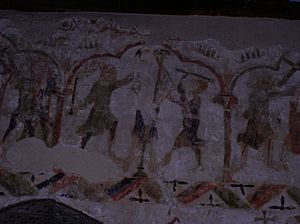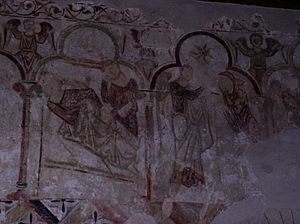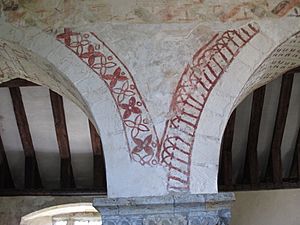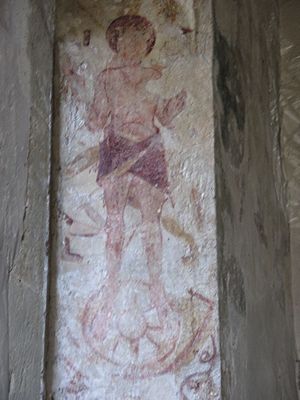St Mary's Church, West Chiltington facts for kids
Quick facts for kids St Mary's Church, West Chiltington |
|
|---|---|
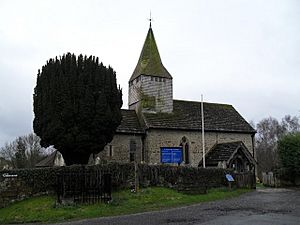
The church from the northeast
|
|
| 50°57′15″N 0°26′57″W / 50.954232°N 0.449305°W | |
| Location | Church Street, West Chiltington, West Sussex RH20 2JW |
| Country | England |
| Denomination | Anglican |
| Website | [1] |
| History | |
| Founded | 11th century |
| Dedication | Mary |
| Architecture | |
| Style | Norman |
| Administration | |
| Parish | West Chiltington |
| Deanery | Storrington |
| Archdeaconry | Chichester |
| Diocese | Chichester |
| Province | Canterbury |
St Mary's Church is a very old and special church in West Chiltington, a village in West Sussex, England. It's an Anglican parish church, which means it's a local church for the community. The building was built in the 12th century, over 800 years ago!
People say it's a "showpiece" because it has so many interesting historical and architectural parts. For example, it has a very long "squint" (a special viewing hole) and some amazing wall paintings. One expert, Ian Nairn, even said it looks like a charming French village church.
Contents
History of St Mary's Church
The first mention of a church in West Chiltington was in the Domesday Book of 1086. This book was a big survey of England ordered by William the Conqueror. It's not clear if parts of that very first church are still in the building today.
However, experts believe the current church was mostly built in the early 1100s. The main parts, like the walls of the nave (the main seating area) and the chancel (the area around the altar), might even be from the 1000s.
Around the year 1200, a south aisle was added. This is a side section of the church. Later, in the 1200s and 1300s, more chapels were built. A tall, pointed roof called a spire was added in 1602.
The church was repaired and updated between 1880 and 1882. For a long time, no one knew which saint the church was named after. Then, in 1541, a will was found that mentioned "Our Lady of Chiltington." This showed the church was dedicated to St Mary. Records also show that over 3,700 people have been buried in the churchyard over the centuries.
Architecture and Design
St Mary's Church is known for its beautiful design. Some people have even said that if it were in Italy, people would travel far to see it! It was built between 1100 and 1150. This was a time when the Norman architecture style was changing into the Early English Gothic style.
The church has a nave, a chancel, and a south aisle. The chancel arch, which separates the nave from the chancel, is made of two arches. This was built to support the thick east wall and the bell tower above it.
There are still two original round-headed Norman windows. One is in the west part of the south aisle, and the other is in the north wall of the chancel. The only stained glass in the church is in the east window of the chancel.
One very special feature is the "hagioscope," also called a "squint." It's a long, tunnel-like opening, about 9 feet (2.7 meters) long. It goes from the south aisle through a pillar into the chancel. This allowed people in the aisle to see the bread and wine being blessed during church services.
The church roof is covered with Horsham slabs, a type of stone common in this area. The wooden spire, added in 1602, sits partly on the old bell tower and partly on the nave wall.
Church Bells
In 1864, a survey found four bells at St Mary's Church. Each bell was about 34.5 inches (87.6 cm) wide and weighed about 7.23 long tons (7,346 kg). Each bell had a special message or date carved into it.
For example, one bell from 1602 had the words "our hope is in the lord." Another bell from 1665 had the names of two church wardens from that time.
Later, in the 1960s, one of the old bells was remade. A new bell was also added in 1950. This new bell has the words "hear my prayer o god" on it. A brass plate inside the church remembers the person who helped pay for this new bell.
Amazing Wall Paintings
Discovery of the Paintings
The beautiful wall paintings inside St Mary's Church were hidden for many years. They were first found in 1882. Later, in 1931, Professor Tristram worked to treat them. Mrs. Eve Baker then helped to preserve them so they would last.
These paintings are very old, dating from the 12th to the 14th centuries. They include two sets of pictures from the 1200s that tell stories from the Bible. There are also older and newer images. Even today, they give a hint of how amazing the church must have looked when they were first painted.
What the Paintings Show
The oldest important painting is a round design at the east end of the south aisle. It was found in 1967. In the middle, it has a cross made from an "endless knot" of rope. The south aisle also has paintings from the 1100s showing angels and Apostles.
On the south wall of the nave, there are paintings that show scenes from the Passion of Christ. These include:
- Jesus entering Jerusalem
- The Last Supper
- Christ washing his disciples' feet
- The Betrayal of Christ
- The Flagellation of Christ (Jesus being whipped)
- Christ carrying his cross
- The Crucifixion
- An angel at the tomb
On the north wall, there are scenes about the birth of Jesus. These include:
- The Annunciation (when Mary was told she would have Jesus)
- The Visitation (Mary visiting Elizabeth)
- The Nativity itself (the birth of Jesus)
- An angel and shepherd
There are also decorative designs from the 1300s on one of the pillars in the south aisle and on the undersides of its arches.
Christ Standing on a Wheel Painting
In a special part of the north nave window, there is a painting from the 1300s. It shows Christ standing on a wheel. Around him are tools from different jobs, like tailor's scissors, a butcher's knife, a carpenter's square, and a weaver's shuttle. He has his arms raised, as if to show his wounds. There are even two dice above his right shoulder.
You can find similar paintings in many other old English churches. This painting is a warning against working on Sunday. The message is that if people work on Sunday, they are causing new pain to Christ.
St Mary's Church Today
St Mary's Church is a very important historical building. It was given a "Grade I listed" status by English Heritage on March 15, 1955. This means it is considered to be of "exceptional interest" and is important not just locally, but nationally. In February 2001, it was one of 38 Grade I listed buildings in the Horsham area.
The church serves a large area, including West Chiltington village and the nearby areas of West Chiltington Common, Gay Street, Broadford Bridge, and Coneyhurst.
The church holds regular services:
- Sundays: 8:00 am for Holy Communion and 10:00 am for Sung Parish Mass.
- Wednesdays: 9:30 am for Exposition of the Blessed Sacrament and 10:00 am for Holy Communion.
- Thursdays: 9:30 am for Rosary and 10:00 am for a quiet mass.
The church is open every day for visitors who want to explore its history and beauty. Also, on the first Thursday of each month, there's a "Village Cafe - Refresh!" in the Church Hall at 10:30 am. It offers free tea, coffee, and cake, and is a great time to chat and relax.
See also
- Grade I listed buildings in West Sussex
- List of places of worship in Horsham (district)
- St John the Baptist's Church, Clayton
- St Botolph's Church, Hardham


